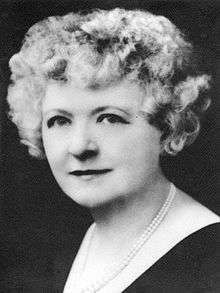Lily Strickland
Lily Strickland (28 January 1884 – 6 June 1958) was an American composer, painter and writer.
Lily Strickland | |
|---|---|
 | |
| Born | January 28, 1884 Anderson, South Carolina |
| Died | June 6, 1958 (aged 74) Hendersonville, North Carolina |
| Nationality | American |
| Education | Converse College, Institute of Musical Arts (later Juilliard) |
| Known for | Music Composition, Watercolorist |
| Spouse(s) | Joseph Courtenay Anderson
( m. 1912–invalid year) |
Biography
Lily Strickland was born in Anderson, South Carolina, of parents Charlton Hines Strickland and his wife Teresa Hammond Reed. When her father died, the family moved into the home of her grandparents, Judge and Mr. J. Pinckney Reed. Strickland began studying piano at age six and began composing in her teens. She studied piano and composition at Converse College and in 1905 received a scholarship to study at the Institute of Musical Arts (later Juilliard) in New York City.[1]
In 1912 she married Joseph Courtenay Anderson, an English teacher at Columbia University. When Anderson became manager for an American company in 1920, the couple moved to Calcutta, and spent the next ten years in India. Stickland traveled in Africa and Asia, painted and published articles in American magazines. She received an honorary doctorate in music from Converse College in 1924 in recognition of her success as a composer.
Strickland composed works that were used in the silent cinema, art song, and solo piano works. As an early ethnomusicologist, she chronicled her experiences with several musical cultures as a special correspondent for The Music Courier. Her articles include those on Ceylon (The Musical Courier, vol 86, no. 9); music at Hindu Temples (vol. 86 no. 13); "Natuch" dancing (vol. 87, no. 15); snake charmers and music (vol. 87, no. 19); "devil dancing" (vol. 87, no. 20); Tibetan Buddhist music (vol. 87, no. 21); and music related to Krishna (vol. 87, no. 22). She also published several similar articles in The Etude, and was featured by The Etude in several article about her own compositions.[2][3]
The Andersons returned to New York, and in 1948 retired to a farm near Hendersonville, North Carolina. Strickland died of a stroke in 1958.[4]
Works
Strickland published 395 works, including popular and sacred music and children's songs. Her early compositions were influenced by spirituals and folk songs from the American South, and later works by Asian and African music. Selected works include:
- Mah Lindy Lou
- Ballade of la belle dame sans merci (Text: John Keats)
- Love wakes and weeps (Text: Sir Walter Scott)
- My lover is a fisherman (from Songs of India)
Strickland's music has been recorded and issued on CD, including:
- AMERICAN INDIANISTS, Vol. 2, Marco Polo (1996)
Strickland was also a prolific painter of watercolor, most of which was done during her time abroad. The largest collection of her paintings can be found at the Anderson University Art museum, in Anderson, SC
References
- Sadie, Julie Anne; Samuel, Rhian (1994). The Norton/Grove dictionary of women composers (Digitized online by GoogleBooks). Retrieved 4 October 2010.
- Strickland, Lily (1923–24). "The Music of India (series)". The Musical Courier. 86-87.CS1 maint: date format (link)
- Strickland, Lily (1931–32). "Music in Asia". The Etude. various.CS1 maint: date format (link)
- "Strickland, Lily (1884-1958)". Archived from the original on 12 September 2012. Retrieved 15 November 2010.